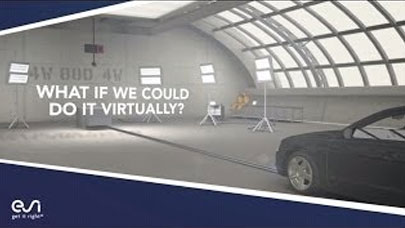The automotive world is changing, from automated production lines to tighter safety and emissions legislation. But perhaps the most significant change in the industry is the move towards Virtual Reality – automotive industry’s new best friend. Virtual Reality allows engineers to get inside a car before it is built, gaining a much better idea of how it will be used by their customers, and allowing manufacturers to ultimately save both money and time by building a better performing, safer car.
During product development, computer-aided design (CAD), computer-automated design (CAutoD) and computer-aided engineering (CAE) software helps engineers quickly explore the performance of thousands of design alternatives without investing the time and money required to build physical prototypes. Indeed, Virtual Reality is increasingly used in the manufacturing of cars as it not only assists engineers when it comes to the car’s aesthetics and performance, but also plays a key role in safety.
Prediction is the key
As safety requirements keep increasing, car designers are required to save on weight and costs, while rolling out an increasing number of variants. By using predictive virtual testing to model how a car will behave on different road conditions, engineers can determine how all the car’s components will work together to keep the occupants safe in the event of a crash.
Virtual Reality was first introduced into the automotive industry 10 years ago, and it is clearly here to stay. So who do the major automotive manufacturers turn to for their Virtual Reality solutions? For Ford, Renault, Audi, and many others, it’s ESI Group. Based in Paris, France, ESI is a recognized leader in the fields of virtual product engineering and Virtual Prototyping. The company, which has been serving clients for more than 40 years, employs more than 1,000 specialists and works with customers in 40 countries.
Dr Michael Kerausch, ESI’s Director of Immersive Experience, said: “Today car manufacturers are under intense pressure from consumers to deliver new models every couple of years. The popularity of these new cars is inextricably linked to the financial success of the company, so it is imperative manufacturers get it right. By getting inside the virtual world of the car, engineers can gain a much better idea of how their designs will be used by their customers, thus manufacturing more appropriate models, saving both money and time.”
A long-term ESI-Audi collaboration
Since 2009, engineers at Audi have been using ESI’s IC.IDO solution at their Ingolstadt and Neckarsulm plants to run virtual simulation so they can anticipate and solve process related issues before the first car comes on the production line.
Audi carries out investigations in their Pre-Series Centre to check individual assembly steps virtually. This way it can be determined whether the assembly can actually be carried out as planned by production staff. Assembly is simulated by virtually handling components in the 3D environment of Audi’s Cave Automatic Virtual Environment, or CAVE for short.
Although it shares its name with a Stone Age dwelling, CAVE is anything but prehistoric. CAVE is cutting edge technology consisting of projection surfaces on the floor and wall onto which 3‑D images of components are displayed. The result is a virtual world into which pre‑series developers control the virtual components using an intuitive hand-held controller and 3‑D glasses.
Audi explains that ESI’s IC.IDO’s collision recognition in combination with the haptic feedback from the controller allows them to get a feeling for the feasibility of the assembly before the first prototypes are built. In this way, potential problems in series production can be recognized and resolved in early project phases. So how has using ESI’s Virtual Prototyping system helped to make Audi’s processes more efficient and improved the quality of their cars?
The benefits of early stage problem solving
Audi confirms that conceptual problems can be recognized and resolved at an early stage in the development process by using virtual methods including IC.IDO. This has the advantage that problems identified virtually are easier and faster to solve through computer-based design change instead of later, more costly hardware changes. Virtual validation is ideally carried out before the production of the required tools, so that Audi does not incur costs for tool modifications. In addition, various versions can easily be represented and examined in the virtual world, so the number of pre-series vehicles required for ensuring optimal assembly can be reduced.
So what does the future hold for Virtual Reality in the automotive industry? For Audi it’s about using Virtual Prototyping to help pick up and move components more intuitively. Indeed, the company is currently testing the Myo, an armband developed in the gaming industry for gesture control, to see how it could be used in the automotive industry. But it doesn’t stop there. Audi also hopes to use virtual methods to help simulate the assembly of flexible components; the first step being the simulation of cable sets and hoses for cooling systems.
Research verifies the benefits of Virtual Prototyping. US firm Aberdeen Group, reports that best-in-class manufacturers which make extensive use of simulation early in the design process hit revenue, cost, and launch date and quality targets for 86% or more of their products. Best-in-class manufacturers of the most complex products get to market 158 days earlier with $1.9 million lower costs than all other manufacturers.
So, the next time you’re thinking about designing a new model of car, why not join other forward looking manufacturers, make a new best friend of Virtual Prototyping, and see just how much it can help improve performance, design and safety as well as save you money and time? And that’s not virtual, that’s a reality!
More around this topic...
In the same section
© HPC Today 2024 - All rights reserved.
Thank you for reading HPC Today.



























